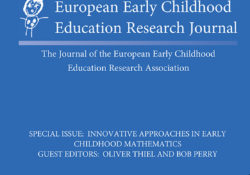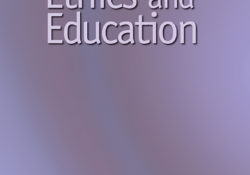eric.ed.gov har udgivet: For many adults, geometry is a mathematics topic that immediately makes sense to them and gives them confidence in their ability to learn, while other adult learners identify geometry with failure. Most adults, however, do recognize the need for measurement, and many have a basic understanding of measurement concepts, although they may need to learn English measurements if they already know metric measurement. Implications for teaching and learning are the following: (1) teachers must use exact and estimated measurements to describe and compare phenomena to increase the understanding of the structure, concepts, and process of measurement; (2) teachers must address the impact of measurement skills on self-efficacy and self-reliance; (3) measurement skills should be extended to concept areas such as volume, proportion, and problem solving; (4) teachers… Continue Reading →
Like this:
Like Loading...
tandfonline.com har udgivet en rapport under søgningen “Teacher Education Mathematics”: Abstract Formulae display:?Mathematical formulae have been encoded as MathML and are displayed in this HTML version using MathJax in order to improve their display. Uncheck the box to turn MathJax off. This feature requires Javascript. Click on a formula to zoom. Abstract Researches in “point-free geometry”, aiming to found geometry without using points as primitive entities, have always paid attention only to the logical aspects. In this paper, we propose a point-free axiomatization of geometry taking into account not only the logical value of this approach but also, for the first time, its educational potentialities. We introduce primitive entities and axioms, as a sort of theoretical guise that is grafted onto intuition, looking at the educational value of the deriving… Continue Reading →
Like this:
Like Loading...
eric.ed.gov har udgivet: The purpose of this study is to investigate how students’ in senior grade of the high school participate in and interpret the transformational geometry activities integrated with cultural context. 5 students in senior grade participated in this study, all of whom live in Aydin district of Turkey. The main design of the study is qualitative. Participant students of the study involved in 9 different rotational geometry and culture integrated activities, 7 of which were performed as student activity sheets, 2 of which were performed as cultural games. 2 of the activities were constructed as a result of pilot study applied to 28 senior students by their math teacher. To collect data about how students participated in and made interpretations about the activities; various data collection tools such… Continue Reading →
Like this:
Like Loading...
eric.ed.gov har udgivet: In a study about pre-service secondary mathematics teachers’ (PSMTs) understanding about the nature of theorems in geometry, the researcher noticed that it was challenging for the PSMTs to visualize and draw counterexamples to disprove the given mathematical statements. Meanwhile, the use of the dragging feature of dynamic geometry environments (DGEs), such as the Geometer’s Sketchpad and GeoGebra, in teaching and learning proof and reasoning has been widely discussed and become an ongoing research trend. In this paper, the researcher and her colleague will present a research design aimed at investigating PSMTs’ conceptions of counterexamples in geometric reasoning when using the dragging feature of DGEs. Expected results of the study are potentially beneficial to pre-service/in-service secondary math teachers as well as teacher educators. Link til kilde
Like this:
Like Loading...
tandfonline.com har udgivet en rapport under søgningen “Teacher Education Mathematics”: ABSTRACT ABSTRACT This study explores preschool children’s mathematizing in everyday block play activities. Building on an ethnomethodological and multimodal conversation analytic framework, we explore how geometry (i.e. spatiality, shape, and symmetry) is actualized in children’s verbal and embodied interaction with their peers, pedagogues, and material environment. The selected data are drawn from a video ethnographic study in a Swedish preschool in which a boy and a girl play with a magnetic construction toy. The results of the study demonstrate how the participants orient to spatial locations, properties, dimensions, orientations, transformations, and shapes as they build a house. The children are shown to rely upon verbal and embodied resources such as deictics (e.g. here, there, these) and pointing gestures as geometrical aspects are… Continue Reading →
Like this:
Like Loading...
tandfonline.com har udgivet en rapport under søgningen “Teacher Education Mathematics”: Abstract Abstract Inspired by Adriana Cavarero’s recent work on maternal inclinations as a postural term, the overall purpose of this article is to seek out a geometry of the educational relation that is alien to the masculine myth of the ‘economic man’. Drawing on Jan Masschelein and Maarten Simons’s critique of the marketization of education, reading their giving ‘shape and form’ to the scholastic school through the geometry of Cavarero’s ‘maternal inclinations’, the article shows how images and metaphors associated with the posture of rectitude infuse the scholastic model of the school. At the same time, we argue, it testifies to a geometry of an inclined subject and, in doing so, it offers an opening for recovering the significance of… Continue Reading →
Like this:
Like Loading...
eric.ed.gov har udgivet: Considering the performances of the students in the Timss and Pisa examinations, it is seen that they can not solve the problems, do not animate the objects they can not ask geometry questions in three dimensions and can not understand them. For this reason, origami lessons should be put into teacher training programs. Secondary teacher trainees were examined in this study according to their views about using origami activities in maths courses. This qualitative study was carried out with 18 secondary mathematics teacher trainees. Data were gathered by semi-structured interview and 3D tangible materials. Findings revealed that prospective teacher candidates can associate large quantities of mathematical and geometric concepts with some achievements and that they have a constructive view on origami activities. However, it was seen that… Continue Reading →
Like this:
Like Loading...
eric.ed.gov har udgivet: “Setting the Stage with Geometry” is a new math program aligned with the National Council of Teachers of Mathematics (NCTM) standards that is designed to help students in grades 6-8 build and reinforce basic geometry skills for measuring 2D and 3D shapes. Developed by The Actuarial Foundation, this program seeks to provide skill-building math activities to help students become successful in the classroom and in real-world situations outside of school. Link til kilde
Like this:
Like Loading...
eric.ed.gov har udgivet: Geometry is an essential component of mathematics which promotes the development of critical thinking and problem-solving skills. Geometry shapes are an integral part of our lives. This study focused on the teachers’ practices, specifically on how teachers ought to be equipped with a good understanding of the effectiveness of the use of diagrams in geometry teaching and learning. A mixed-method approach comprising of questionnaires and interviews was used in this study. Ninety-one teachers participated in this study. The research findings were categorized using the four themes of utility, positive attitudes, negative attitudes, and teachers’ use of diagrams in geometry class. The study showed that diagrams are effective in the teaching and learning of geometry concepts. It is recommended that teachers could do well if they make use… Continue Reading →
Like this:
Like Loading...
tandfonline.com har udgivet en rapport under søgningen “Teacher Education Mathematics”: ABSTRACT Formulae display:?Mathematical formulae have been encoded as MathML and are displayed in this HTML version using MathJax in order to improve their display. Uncheck the box to turn MathJax off. This feature requires Javascript. Click on a formula to zoom. ABSTRACT This paper deals with a set of geometrical problems for mathematical problem-solving at different difficulty levels. All of these are presented as national flags and one has to investigate invariant area proportions when changing the locus of any corner of the flag. This dynamic element suggests the usage of dynamical geometry environments. Considering applications in mathematics classes, it allows training students’ ability to find a proof above all in the phases of production of a conjecture and exploration… Continue Reading →
Like this:
Like Loading...



